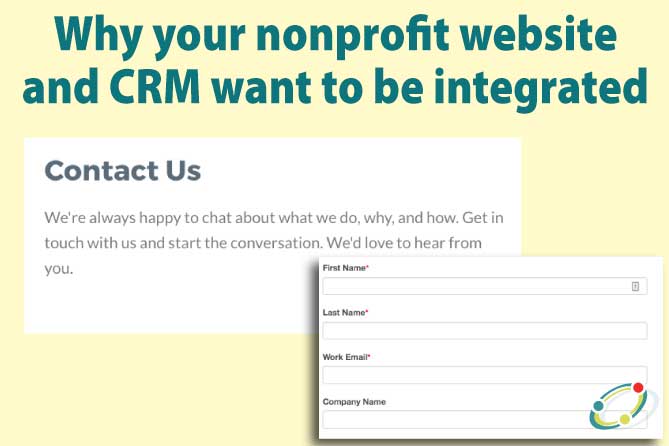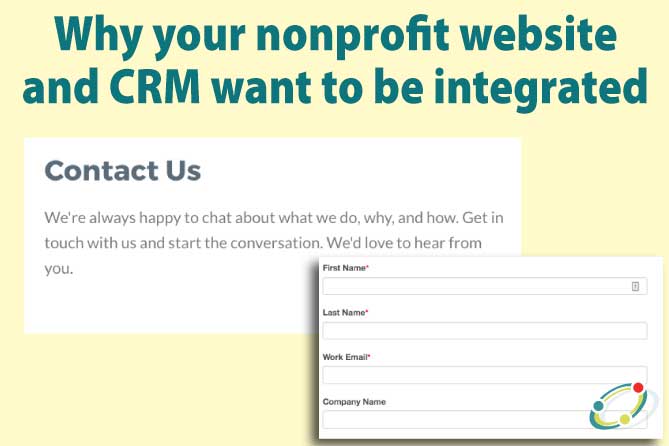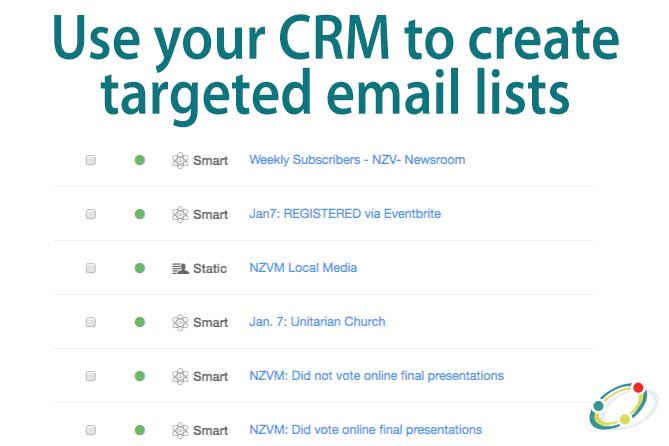How to Use Your Core Values to Inspire, Retain, and Energize Your Team
For the last few decades, but especially so in recent years, people are seeking out more than just an income from their place of employment. More...


Relying on spreadsheets to keep track of your organization's donors, volunteers, and other contacts gets tiresome and ineffective quickly. But many nonprofit managers with strong websites shy away from integrating tools like CRMs (Customer, or Constituent, Relationship Management) software that are designed to help you manage contact lists or databases of members, volunteers, donors or subscribers. Why?
It is likely your nonprofit has been using an email service such as Constant Contact, MailChimp or AWeber for years now. There is one person (usually) in your organization who knows how to use the tool well to send out your newsletters and event announcements. Meanwhile, there may be someone else who is the master of maintaining your donor records using a different software like Little Green Light or DonorPerfect. These tools are viewed as separate and independent of your website.
Your website need not be an isolated tool. Your site is the foundation of your effort to provide information and open the dialogue with visitors. Whether you are a business, government agency or nonprofit/NGO, people inside and outside your organization drive your success. CRM is the way you can manage relationships and measure success. Integrating CRM into your website will help you capture information to develop relationships with your C – whether “C” is customer, constituent, contact, or contributor.
In the commercial business world, CRM is typically referred to as “Customer Relationship Management” systems. In the nonprofit/NGO world, you may hear the term “Constituent Relationship Management”. A CRM’s primary purpose is to organize, track, and manage all of your contact information so it is actionable. You can think of CRM as a rich database of information about your contacts that also includes an email address, rather than an email address list that may include a few other points of information.
CRM also serves your customer service and support function — making organizations more efficient and improving satisfaction. In any organization, the bottom-line of a CRM work flow is to (1) Initiate communications, (2) Nurture relationships, (3) Process donations or memberships and (4) Provide support.
It’s likely you already use some form of tool, even if it is an Excel spreadsheet, to track donors. A CRM software expands tracking into action. A robust CRM will let you manage key data and improve communications.
A CRM helps with managing memberships and renewals, or donors and appeals. Some CRM software specialize in donor tracking, while others focus on automation – responding to inquiries or nurturing contacts. All CRMs help develop targeted mailing and email lists.

As a nonprofit/NGO, your needs are different from a business. Membership organizations will likely want membership or subscription management, while charitable organizations are likely to have a greater need for donor tracking.
CRM can be either a software or service, or combination of services. Integrating several pieces of software together, or modules, increases the functionality.
Additionally, several donor management platforms integrate with full-featured CRM software, such as SalesForce or an email communications service like Constant Contact or Mail Chimp.
The first and easiest ways to combine CRM and your website is the use of website contact forms. Passing data from a form on your website into your CRM, and using your CRM to automate some action, such as sending a reply email.
If you’re using WordPress, you may have already integrated a Constant Contact or Mail Chimp form so visitors can sign up for your newsletter. This simple integration helps build your subscriber contact list so you have the opportunity to continue building a relationship.
An other easy implementation is creating landing pages with forms to deliver specific information such as a research report and then follow up with nurturing messages.
A more complex integration may involve several pages, emails, offers and workflows. An automation workflow would trigger an action based on pages visited and other information, such as events attended or date of last gift.
Your CRM can be more powerful than just collecting email addresses. A fully implemented CRM includes automation to help nurture leads (customers or donors), follow up inquiries and flag interests. It can identify when a past donor visits your website. You might send that past donor an appeal email if they visit your site to learn of a new initiative or project.
CRM also helps with memberships. A membership organization may have annual or rolling memberships that require renewal. CRM can help with sending renewal notices, tracking response and follow up to contacts that don’t renew.
Donor and member management CRM can be combined with website data to delivery a more personalized experience for the user. A past member visiting your site may see a call to renew their membership, while a current member may be served information about current projects, and a new visitor would see information about joining your organization.
The Change Conversations blog is where changemakers find inspiration and insights on the power of mission-driven communication to create the change you want to see.
© 2009- to present, Marketing Partners, Inc. Content on the Change Conversations blog is licensed under a Creative Commons Attribution-Noncommercial-NoDerivs 3.0 United States License to share as much as you like. Please attribute to Change Conversations and link to ChangeConversations.
Creative Commons License may not apply to images used within posts and pages on this website. See hover-over or links for attribution associated with each image and licensing information.

For the last few decades, but especially so in recent years, people are seeking out more than just an income from their place of employment. More...

You know nonprofit organizations need websites just as small businesses do, but you may be surprised to learn nonprofit sites can be more complex and...

In today’s rapidly evolving media landscape, understanding where and how your story is told isn’t just strategic—it’s essential. How you communicate...